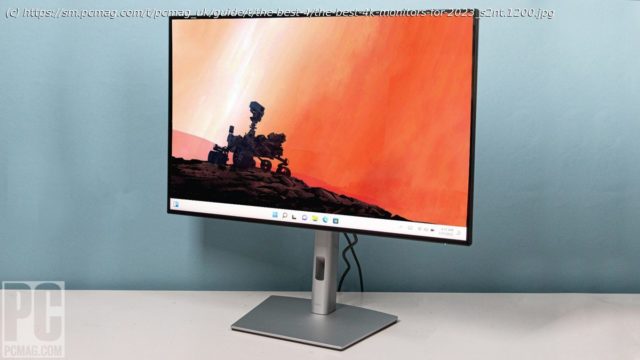Fast becoming mainstays of gamers and creative pros, 4K monitors are falling in price—but getting more complicated to buy. Here’s how to shop for an ultra-high-definition (UHD) display, plus our top picks from deep-dive reviews.
Ready to buy a 4K monitor? Let’s define 4K first. The vast majority of 4K monitors have 16:9 aspect ratios with a native resolution of 3,840 by 2,160 pixels (horizontal by vertical). That’s four times as many as a full HD or 1,920-by-1,080-pixel panel—and that’s a lot of pixels. Some other resolutions with approximately 4,000 pixels across—most commonly 4,096 by 2,160—are also considered 4K. All these panels remain premium choices, but they’re becoming increasingly common on desks at work, at home, and in gamers’ frag dens.
But before we get too deep into details, we should help you answer a key question: Is a 4K monitor right for you in the first place? Depending on what you do most with your monitor, and where you’ll place it, the extra money you’d pay versus a lower-resolution display may not be necessary.To 4K or Not to 4K: That’s the Gamer’s Dilemma
For starters, if you want a really big 4K monitor solely for home-entertainment purposes that don’t center on PC gaming, a 4K TV would likely be a cheaper option. That’s because many 4K TV sets aren’t beholden to the same standards that 4K monitors are, such as the need for boosted refresh rates (for gaming models), elite or specialized color accuracy (for content creators), or low input lag. (See our picks for the best TVs, now uniformly 4K models.)
Gaming at 4K is a demanding task that requires you to have relatively powerful hardware inside of your PC. In particular, you’ll need a fast graphics card. If you’re looking to run games with maxed-out graphics settings at 60fps or better you’ll need one of the most expensive graphics cards money can buy. The immensely powerful Nvidia GeForce RTX 4090 is currently best suited for this task, though at $1,599 it’s also prohibitively expensive.
Though you may not sail past 60fps on every game with maxed settings, you can competently run most if not all modern titles at that (or close to that) with several less-expensive GPUs. Nvidia has several upper-end GeForce RTX 40-series cards that are capable of gaming at 4K, and AMD’s Radeon RX 7900 graphics cards are similarly capable. If you drop the graphics settings down, some older graphics cards, like many of those at the upper ends of the Nvidia GeForce RTX 30 series and AMD Radeon RX 6000 series, are also perfectly capable of providing a smooth 4K gaming experience in many games.
Gaming at 4K resolution isn’t strictly about your hardware nowadays. A crop of software technologies (image sharpeners, upscalers, and supersamplers) from both AMD and Nvidia have hit the market recently. In a nutshell, these aim to allow PCs with midrange graphics cards or lesser integrated graphics (and gaming-console GPUs) to run at higher resolution while minimizing the performance hit and loss in visual quality. Next Question: Can You See in 4K?
When shopping in the TV aisle, the answer as to whether you should opt for a 4K model today is almost always yes, because it’s hard to find TVs with lower resolutions these days. It’s not quite as simple with computer monitors. Getting serious about the question comes down to algebra and raises issues like pixel pitch, pixels per inch (ppi), and something called angular resolutions. Let’s try to keep it simple, however.
A good example of the pixel-pitch problem arises with virtual reality (VR) headsets and an issue known as the screen door effect. In essence, the lower a display’s maximum resolution and the closer you sit to it, the easier it is to see its individual pixels. In the case of VR headsets, this can make the image look as if it’s seen through mesh, and it’s why headset resolution has grown steadily—when something’s that close to your eyes, you can more clearly see the difference.
The same considerations apply to monitors, just across a viewing distance measured in feet instead of inches. The tricky bit is that viewing distance isn’t fixed but depends on the size and layout of your desk, your chair position, and so on. Whether you can make out the difference in image quality between a 4K display and, say, a 1440p panel (2,560 by 1,440 pixels) depends on not only the distance but your eyesight and the screen size. The last calculates out to a certain number of pixels per inch, in essence the screen’s pixel density. You can see how it scales here at each common resolution.
Luckily, we don’t have to the math on our own. Workstation vendor Puget Systems has designed a helpful Google Sheet that will automatically help you figure the optimal display size and resolution for you depending on your personal visual acuity. All you have to do is plug in your target screen size and resolution, the distance between your eyes and the screen, and the specifics of your eyesight. You can then try different numbers and see how the output changes, helping you figure out if a certain size or distance makes more or less sense. (If you haven’t been to the eye doctor lately and don’t know your prescription strength, a few more calculations using some of the formulas on this page are all you need.)
Of course, less scientifically, you can look at 4K panels of various sizes in a local store to see if you can tell the difference between them and similarly sized 1440p or 1080p monitors. But ideally you’ll want to observe the same screen image, scaled the same amount, to get a meaningful comparison, and that may not always be practical.
Still, to summarize: Before you buy a 4K monitor, make sure you’ll actually be able to see the benefit of the increased pixel density given your seating setup. If you have 20/15 vision, sit three feet from the screen, and already own a 27-inch, 1440p display, you probably can’t justify the cost of a 27-inch, 4K monitor.






